Are you a Quiet Speculation member?
If not, now is a perfect time to join up! Our powerful tools, breaking-news analysis, and exclusive Discord channel will make sure you stay up to date and ahead of the curve.
My Ixalan spoiler review covered cards leaked back in June, and was published well before Wizards revealed the full expansion. As such, it didn't discuss Chart a Course, a spell spoiled during the Magic: Arena unveiling that has me giddier than anything else in the set.
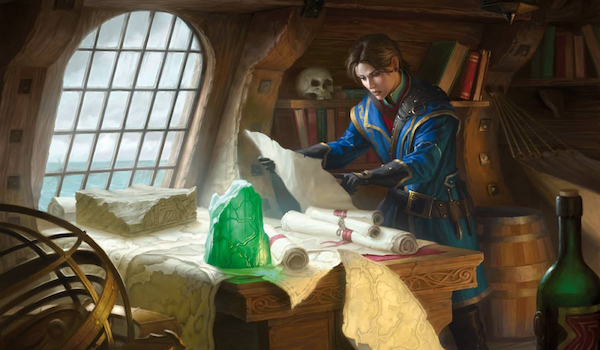
Chart a Course has shown promise in my go-to Delver deck, Counter-Cat. This article closely analyzes the card there, primarily in relation to its main foil, Snapcaster Mage.
Plundering Secrets
I've written about drawing extra cards in threshold decks before. In short: it rules. Thresh is loaded with cards so efficient it can afford to make tempo-negative plays (like cast cantrips) and yet play to establishing and maintaining a board advantage, so drawing into more of them at a discounted rate is hugely powerful. While Chart a Course is no Gush or Treasure Cruise, it does offer thresh players more cards on the cheap.
Chart a Course: Face Value
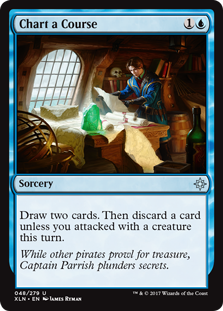
Chart has something special over equally costed selection cantrips like Anticipate and Strategic Planning: it fixes our hand. Cantrips that interact with the hand are among the best (see: Brainstorm), as they give casters more options. The benefit of hand-fixing on a cantrip is so high that I've included Faithless Looting in decks with little to no graveyard synergy.
Obviously, though, Chart excels in a deck that attacks throughout the game. Its ensuing Divination mode vividly evokes Night's Whisper. Whisper is seldom played in Modern outside of critical-mass combo decks like Grishoalbrand, for a couple reasons: first, Modern has always been tempo-centric, deterring players from casting two-mana sorceries that don't impact the board; second, Whisper's life loss adds up over multiple copies, further compounding the tempo issue. Modern decks skip out on Dismember for similar reasons, despite the card being one of the most efficient and reliable kill spells in the format—they're already built to push their life totals to the limit relative to their aggro matchups.
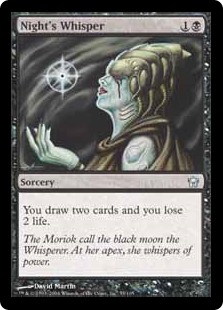 Whisper sees play as a one- or two-of in Czech Pile, the new poster-boy for fair Legacy decks. That deck is a literal "pile" of the 60 best cards in the format. Whisper isn't even blue for Force of Will, testifying to the potential of a two-mana "draw two" and reminding us that pure card advantage at this price point is scarce and exciting.
Whisper sees play as a one- or two-of in Czech Pile, the new poster-boy for fair Legacy decks. That deck is a literal "pile" of the 60 best cards in the format. Whisper isn't even blue for Force of Will, testifying to the potential of a two-mana "draw two" and reminding us that pure card advantage at this price point is scarce and exciting.
Chart is significantly better than Whisper in shells that can support it, as noted by Jarvis Yu in an article that has him singing its praises for eternal formats. And Modern has become less tempo-centric with the arrival of Grixis Shadow, which also bodes well for the card.
Whether Chart a Course succeeds here depends on if it finds a home. Of course, Pile-style rock decks can't assimilate Chart themselves; such decks spend early turns disrupting, not attacking. Neither can linear aggro, which favors blitzing opponents to out-grinding them. That leaves spell-based tempo, or threshold decks.
Chart in Counter-Cat
When it comes to thresh decks in Modern, I feel Counter-Cat is the strongest option. And at a glance, it seems Chart fits perfectly into that deck. Chart gets us ahead on cards in grindy games without compromising our core gameplan, a previously impossible feat (Modern's other card advantage tools are tough for Delver decks to adopt). In doing so, the spell addresses one of Counter-Cat's longstanding weaknesses.
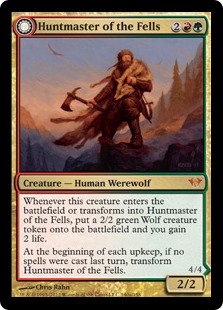 Counter-Cat occasionally chokes on mana and struggles to play out its cards optimally; in these scenarios, clunky midrange spells like Snapcaster or Huntmaster can clog. But Chart plows through the deck and into land drops. Besides netting us mana over longer games, Chart does work in a flood, launching us into mini-combo turns wherein we string a bunch of cantrips together and refill on business. As Treasure Cruise taught us, cards beget cards.
Counter-Cat occasionally chokes on mana and struggles to play out its cards optimally; in these scenarios, clunky midrange spells like Snapcaster or Huntmaster can clog. But Chart plows through the deck and into land drops. Besides netting us mana over longer games, Chart does work in a flood, launching us into mini-combo turns wherein we string a bunch of cantrips together and refill on business. As Treasure Cruise taught us, cards beget cards.
The discard clause on Chart is barely a drawback here. With eight functional Delvers and seven functional Goyfs, Counter-Cat is built to apply pressure quickly, allowing us to skirt it altogether. And in lieu of an attacker, Counter-Cat is bound to stockpile dead fetches in longer games, which Chart chews past admirably.
Accommodating Chart
Our most recent build of Counter-Cat, which features Disrupting Shoal, has performed well for Kelsey and I in the current metagame. I wanted to keep its core constant when incorporating Chart. Doing so involved establishing the build's essential pieces, so that I could tweak the uncovered flex spots freely in testing to identify the right number for the Ixalan uncommon.
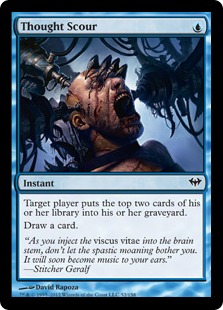 At first, I excluded Mandrills #3 and the Scours from this list. I knew I needed two instant-speed cantrips, and figured I could trim the Ape and run Opt instead if a build called for it. Mandrills naturally proved too exceptional to only include at two copies, and in my preliminary testing with Opt, I ended up missing the velocity from Scour even on zero Snapcasters. After tinkering with several configurations, I realized running two Scours to support a third Mandrills was indeed optimal, and included that package in the core.
At first, I excluded Mandrills #3 and the Scours from this list. I knew I needed two instant-speed cantrips, and figured I could trim the Ape and run Opt instead if a build called for it. Mandrills naturally proved too exceptional to only include at two copies, and in my preliminary testing with Opt, I ended up missing the velocity from Scour even on zero Snapcasters. After tinkering with several configurations, I realized running two Scours to support a third Mandrills was indeed optimal, and included that package in the core.
Since Sleight of Hand and Chart a Course are both sorcery-speed cantrips, I also excluded Sleight from the core's first draft, at one point testing a list with 4 Serum, 4 Chart, and 0 Sleight. I soon realized running a pair was integral to repairing precarious openers, despite paling in early-game effectiveness compared with Serum Visions. Sleight offers the next-best-thing in terms of hitting that crucial second land drop, and of course wows as a topdeck.
Counter-Cat w/ Shoal: Core
With our standard 18 lands, the core leaves 4 spots for other cards—all of them blue to surpass Disrupting Shoal's magic number, 22. I wanted 2 Chart a Course at minimum, but since it's a novel addition, I didn't include it in the core. Realistically, then, we have two slots remaining. I messed around with these options in varying combinations all week.
- 1 Snapcaster Mage: Ideal for metagames teeming with aggro-control and aggro-combo. We can't play more than one of this expensive creature main.
- Disrupting Shoal #4: Ideal for linear aggro and combo metagames. Chart ups our ability to Shoal for two, the ultimate number (we have Leak/Pierce up for three-drops and generate the most tempo from countering a two-drop for no mana). It also helps negate Shoal's card disadvantage, and Shoal lets us continue interacting while tapping out for Chart on turn two. Chart even draws us into the lands that make hard-casting Shoal attractive later.
- 1-2 Spell Snare: Post-Fatal Push, Snare's stock dipped as its prey was squeezed out of the format. Decks like Eldrazi, Company, and even Shadow make a mockery of the card. Snare has served Counter-Cat well over the years, but I was relieved to cut it from this new build.
- Sleight of Hand #3: 4 Sleight was always too many in testing, as it's never phenomenal early. Still, it does repair lacking hands better than Chart at only one mana. Chart is predominantly the better topdeck.
- Chart a Course #3-4: For more on this card, keep on reading.
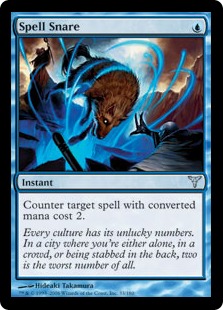 Spell Snare wasn't missed in testing. Our costed permission exists to trade one-for-one with spells we can't cleanly answer with removal, like Primeval Titan, Collected Company, and planeswalkers. All Snare tackles in this category is Snapcaster Mage. I tried the fourth Shoal to compensate for the lack of Snare; it ended up being superfluous.
Spell Snare wasn't missed in testing. Our costed permission exists to trade one-for-one with spells we can't cleanly answer with removal, like Primeval Titan, Collected Company, and planeswalkers. All Snare tackles in this category is Snapcaster Mage. I tried the fourth Shoal to compensate for the lack of Snare; it ended up being superfluous.
The battle between Snapcaster Mage and Chart a Course is a bit more complicated, so we'll explore that in detail.
Snapcaster vs. Chart
Snapcaster Mage and Chart a Course fulfill alike purposes in Counter-Cat: they trade our mana for cards. They do so in dissimilar ways, and are each suited to disparate game states. This section illustrates their conflict.
We'll center this debate around the mana factor. Gone are the days of slamming Snapcaster Mage on turn two and flashing back Gitaxian Probe for zero; now, plussing off the Wizard costs at minimum three mana (two for Snap himself and more for the flashed-back spell). Chart a Course offers a more conditional plus (we need to have attacked), and costs just two mana. Both spells put us up by one card. So what does Snapcaster offer us that Chart doesn't to justify its steeper mana cost?
Draws to Snap
The two cards we "draw" with Snapcaster Mage are set in stone. One is an instant or sorcery in our graveyard, which we must cast this turn. The other is a 2/1 body with flash. Comparatively, Chart a Course always offers us mystery cards, barring a scry—the two on top of our deck. This divergence forms the backbone of Snap's pros and cons over Chart.
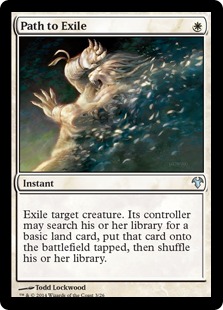 Chart is unparalleled in straight attrition matchups, since we just need cards there; Snap wins out in games that become more answer-focused. He's great in matchups where we want more copies of a key spell such as Path to Exile, since he lets us run a functional five—Chart amasses our existing resources; Snapcaster creates more.
Chart is unparalleled in straight attrition matchups, since we just need cards there; Snap wins out in games that become more answer-focused. He's great in matchups where we want more copies of a key spell such as Path to Exile, since he lets us run a functional five—Chart amasses our existing resources; Snapcaster creates more.
In terms of matchups, Snapcaster appears better suited for two types of opponents: removal-heavy aggro-control and linear aggro-combo.
Snap affects the board, either by establishing or enhancing a clock, or by flashing in to block an opponent's creature. That gives him the edge against decks preventing us from ever establishing a clock, perhaps more so now that attacking soups up our cantrips. Overloading enemy removal is our goal in these matchups, and we'd frequently prefer one of the cards we net off our plussing spell be a 2/1 on the field than a blind pull.
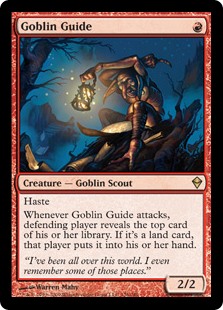 Snap triumphs during races, too: where tempo matters, so does a body. That includes aggro-combo. Take Burn, where flashing back Bolt or Pierce while turning sideways or trading with Goblin Guide is infinitely more appealing than tapping down lands in the main phase to draw cards.
Snap triumphs during races, too: where tempo matters, so does a body. That includes aggro-combo. Take Burn, where flashing back Bolt or Pierce while turning sideways or trading with Goblin Guide is infinitely more appealing than tapping down lands in the main phase to draw cards.
Unlike Chart, which can theoretically become two fetchlands, Snap cannot "miss." He also plusses every time, whereas Chart sometimes asks us to discard. This fidelity is Snap's chief boon: he always represents a 2/1 and a binned instant or sorcery. His other main perk: Snap's interactivity buys us time, so he amends threatless hands and combats targeted discard. No card in the deck plays better from behind.
Draws to Chart
There are times when a 2/1, or the cards in our graveyard, don't matter. Chart offers hope regardless of the situation.
For example, Snap does very little in the early game. If we don't have instants or sorceries we want to flash back in our graveyard, he's nearly uncastable. But Chart a Course joins Goyf as a sweet follow-up to a one-drop. We rarely need to hold up countermagic as of turn two in this deck, so Chart a Course gives us a second-turn play that proactively advances our gameplan without overcommitting resources to the board. Chart can also be resolved early to sculpt our hand, attack or no.
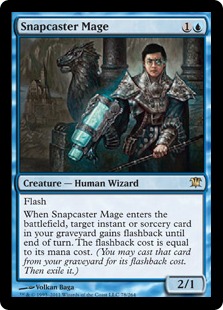
So Chart's got the advantage early on. What about later? I originally thought Snapcaster Mage was strictly better late-game than Chart a Course. After all, we'll have a juicy graveyard by then, not to mention enough mana to invalidate Snap's most immediate pitfall. Chart has pulled me deeply ahead in enough late-games that I've come to reconsider this position.
At the end of the day, drawing two in a cantrip-heavy, bomb-heavy, 18-land deck is ridiculous, especially in the mid- to late-game when five or six of our lands have been fetched out. I've found the raw harvest of Chart's rips to rival the utility of Snap's precision in many games, although sometimes we really do want a particular card, and happen to have a copy sitting in the graveyard.
Chart also ignores grave hate. When opponents land Rest in Peace, Snapcaster's simply a sad body. Sans Chart, we'd be locked out of card advantage avenues until our fourth land drop.
Following that thread a bit, Chart beats out Snap at locating undrawn cards. That boosts its value post-board, when we badly want to see Tamiyo, Field Researcher, Ancient Grudge, Pyroclasm, or other win-buttons. With Charts in the deck, I have found and cast my hate more consistently than ever, as well as resolved better Needles and Explosives—cards with high ceilings and narrow optimal windows gain the most from extra digging.
Finally, Chart harmonizes with our threat suite. An unraided Chart makes us discard a card, which stuffs our graveyard for Tarmogoyf and Hooting Mandrills. And Chart's decisive typing reinforces Delver of Secrets.
Making Peace

There's a limit to the amount of Snaps Counter-Cat can run, both because of his mana cost and because he cuts into our instant/sorcery count. Subsequently, the deck can struggle against grindy midrange strategies. But since our new card advantage spell doesn't have these problems, we can run as many as we choose, increasing our odds against anyone casting Inquisition of Kozilek without sacrificing the integrity of our other components.
That's not to say we should totally abandon Snapcaster Mage. When played together, Chart and Snapcaster gel into a formidable card advantage engine. Snap flashes Chart back to draw more cards, or comes down on the opponent's turn to then attack, enabling raid. He makes for a dynamic pickup with the draw spell.
So, is Snapcaster "better enough" to be worth the third mana? I'm not comfortable dipping below 26 instants and sorceries, and would certainly rather a third Mandrills than a second Snap. But as a singleton, the Wizard earns his spot. I'm even following Kelsey's lead in adding a second to the side—post-board, we have more key spells to rebuy, as well as enough mana to support Snapcaster.
Pawing It All Together
For reference, here's what we ran in the four spare slots pre-Ixalan:
- 1 Snapcaster Mage
- 1 Sleight of Hand
- 2 Spell Snare
Now, I'm on these:
- 1 Snapcaster Mage
- 3 Chart a Course
Kelsey runs another Sleight over the third Chart, and we're watching to determine which is best. Sleight's preferable in mana-light game states, which the deck often encounters pre-side.
Counter-Cat, by Jordan Boisvert
Charting Elsewhere
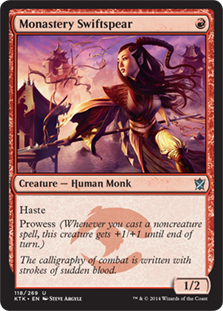
A few players have sought my opinion on Chart a Course in other Delver decks, specifically regarding UR shells. Given the low number of quality threats available to UR, though, that deck already maxes out on Snapcaster Mage, and as such has plenty of card advantage built into its framework. Chart should improve the deck without solving its problems, which makes me less interested in its applications there.
Chart does solve problems for Counter-Cat, though, which already possesses the tools UR lacks: robust threats; heavy-duty removal; sideboard haymakers. An economical, mechanically synergistic way to access more of those tools is just what the veterinarian ordered, and I'm eager to discover exactly how much wind Chart a Course blows into our sails.




This addition brings this deck two of my most favorite terms from business school: velocity and synergy. Love this brew, and I might just have to grab a 4th Goyf and cobble together my own.
Ha, and I know these words as Magic terms. Maybe I should enroll in business school myself!
Awesome list Jordan. Enjoyed reading it. I’d prefer Opts over the Sleights but honestly I’m very biased toward that card haha
Yeah, I’ve found Opt to just be miserable in this kind of deck. Follow this link for a deeper analysis: https://quietspeculation.com/opting-in-modern-cantrips/
And I would suggest testing with Sleight if you haven’t, the card is really good! FWIW, Legacy (formerly Extended) thresh players used to run 4 Sleights alongside 4 Brainstorms pre-Serum Visions, and only played a single Opt at most (usually preferring 0 copies). Having 2x as much info with which to make a choice is big game. Source: http://www.wizards.com/default.asp?x=sideboard/strategy/sb20020124b
I think miserable is a bit strong of a word but I see where you are coming from. I feel like Opt may be worse on Turn 1 because of the awkward case you mention in that article. But in a deck with so many blue instants (and commitments to three other colors) being able to hold up card selection and a counterspell is very relevant. However, Disrupting Shoal makes it significantly safer to tap out on blue than it is in a non-Shoal deck. So I think it Opt is a consideration. I do understand why you chose Sleight though; pros and cons to each card
I mean I think there is a way stronger option that all but invalidates it. Miserable is just the first word that sprang to mind, and I want to keep things PG 😉
We often want to cantrip in main even with say, Leak mana up on the chance we pull say, Pierce and then can play Nacatl and hold up permission anyway, or say, Goyf and would rather play that out, or say, Shoal and then can safely tap out for something else while still having interaction for a given spell. Try with Opt yourself. You’ll see that you are heavily incentivized to cast it in main, meaning Sleight’s “drawback” is actually a boon—sorcery is important for Goyf. And of course, the effect is better, which can’t really be argued.
Sometimes we want to cast instant-speed cantrips, but we have found only often enough to want that kind of effect at 2. Scour is significantly better in that slot since it contributes to our gameplan in other ways. So Opt isn’t even in line to replace Sleight at all, but Scour if anything. Again, refer to the older Extended lists that maxed out on Sleight and rarely played any Opts, despite it being legal; thresh decks prefer Sleight for many reasons, as outlined. Counter-Cat ain’t no UR Breach!
Based on testing I am indeed preferring Sleight in the majority of matchups. On the other hand, the third Chart is feeling pretty clunky but the card is so good in spots that it’s hard to cut. Surgical and Pithing Needle have felt pretty low impact in the matchups I tested them in though. I actually think a couple Ashes of the Abhorrent could be really good in here if Snapcaster was out of the picture (the small nonbo may come up so rarely that it doesn’t matter anyways). What are your thoughts?
Cage > Ashes which isn’t playable in Modern IMO. I actually cut Cage for the second Snap. Needle and Surgical are two of the most skill-intensive sideboard cards in Modern, but I feel both handsomely earn inclusions here, which says a lot since space is tight. So I would think you just need more practice with them. The jury’s of course still out on the third Chart.
Very good article! The comparison bit between Chart and Snap was especially interesting. And above all, that list looks fucking sweet!
Coincidentally, the monthly Modern at my LGS was yesterday and I was planning to bring Counter-Cat! Had to make some not-so-optimal adjustments on the fly but I was able to buy the charts at the store and play something close to your list.
Ended up with:
Main: +1 snap, -1 mandrills
Side: -1 snap, +1 grafdigger’s cage
26 people, went 2-3 (win vs EldraTron and TitanShift, lose vs Merfolk, a brew with 4 magus of the moon main, UB Faeries). Games were mostly close and the deck was a lot of fun to play.
Talking about the list, the 3rd mandrills was missing A LOT, the 2nd Snap wasn’t that useful main and the grafdigger was completely useless side so I’m 100% updating my list for next time. On to the main course (pun intended), chart was amazing every single time. The drawback was relevant maybe once and I casted the card quite a few times. Other than that, it was excellent as a drawing engine. 4 would definitely be clunky but so far, 3 seemed like the correct number.
Cannot wait to play more and to maybe hear some tournament reports from you 😉
Glad you enjoyed it! Against Moon decks, prioritize fetching Forest and Island and take out Paths if you can and you are pretty much immune to the card. Pierce/Bolt will also tide you over while you find your basics with cantrips. Sometimes you keep hands where you don’t have basics but generate so much pressure on the board that tapping out for Moon is a death sentence for your opponent anyway.
As for Merfolk, hold off on finding both red sources or white sources, or you risk getting cut off a color by Seas. Just sandbag a fetch in hand or in play when you can so you can break it and kill something. Not uncommon to blow out attacks by killing lords, and Pyro + removal spell often wipes their board. Remove all counterspells in this matchup.
Faeries doesn’t really beat a Mandrills in my experience, and of course EE/Pyro turn their own Blossom into a win condition for us. Nacatl is great in this MU bc they can’t block it favorably and it’s a high-priority target for Push. Huntmaster will wreck them too. Don’t walk into Spellstutter Sprite; set up a clock and force them to do something. Going wide against all three of these decks is a winning strategy; Faeries is likely to have 1-2 Damnation, but Pierce/Leak/Negate stop it.
This deck is tough to play but once you start learning the matchups you will have a lot of fun and do well. Kelsey almost Top 8’d a 67-man PPTQ with it this weekend (she conceded to me in Round 1 and then was undefeated until the 7th and last round, where she lost her draw-and-in to a pair-down). It’s fun to watch her because she’s learned to play differently against every deck in the field. Counter-Cat has so many tools at its disposal that success with the deck is largely a matter of understanding how its roles shift in different matchups.
Good luck!
Hey Jordan,
can you please explain the role of the SB Tamiyo?
Thanks in advance
Against fattie strats like Shadow and Eldrazi, she freezes the board and lets us get in a couple of big attacks. For more manageable board stalls or when we’re ahead (either on the ground or on life), her plus draws us a couple cards every combat. She’s less good against decks where we just want a ton of removal to break up their synergies (we’re already well set-up here regardless), but absurd vs anyone wielding efficient bodies, Tarmogoyf, Shadow, and Smasher especially.
Huntmaster is better for breaking up synergies and dealing with boards of smaller bodies, so the two kind of compliment each other in the board while both providing bursts of value and a clock of their own against grindy decks (think of the coverage shared by LotV and LtLH). There’s no elegant answer to a 4CMC ‘walker in Modern besides the fringe-played Maelstrom Pulse, which against us is likely to have been spent on something else by the time Tamiyo comes down, so she forces fair decks to remove her in combat. That draws us cards, buys us time, and lets us blow opponents out with blocks and freshly-picked removal.
Counter-Cat has long wanted a ‘walker in the side for the midrange matchup, and Tamiyo does a lot of what we like. Besides, older options like Elspeth Knight, Gideon Ally, and Chandra Torch have never been available to us because costing double W or R makes them uncastable should opponents Seas/Quarter/Edge (or we mill with Scour) a single land of those colors.